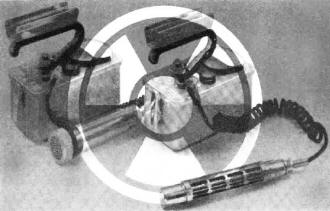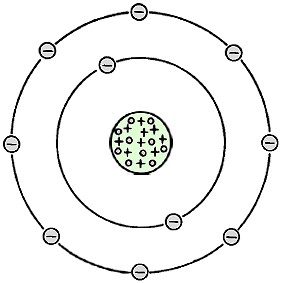|
October 1972 Popular Electronics
 Table of Contents Table of Contents
Wax nostalgic about and learn from the history of early electronics. See articles
from
Popular Electronics,
published October 1954 - April 1985. All copyrights are hereby acknowledged.
|
This is an instance where
I scanned and posted later parts of a multi-month article because I had not yet
purchased the edition with the first in the series, but I have it now. Author J.G. Ello,
of the Radiation Measurements and Instrumentation Electronics Division of
Argonne National Laboratory,
introduces the physics of nuclear radiation along with the genesis and evolution
of nuclear technology. Alpha, beta, and gamma radiation is explained, as is the
decay phenomenon and energy levels. It is all at an introductory level, and from
a classical Bohr model perspective. If you are new to nuclear physics, these
four
articles are a good starting place.
Parts
1,
2, and
3 of this series appeared in the October, November. and December
1972 issues of Popular Electronics, respectively. See also "Nuclear Radiation
... Insidious Polluter" in the February 1972 issue.
Nuclear Radiation & Detection - Part 1: Types of Radioactivity
 Where Alpha, Beta, and Gamma Radiations
Come from and Their Characteristics Where Alpha, Beta, and Gamma Radiations
Come from and Their Characteristics
By J. G. Ello, Radiation Measurements and Instrumentation Electronics Division,
Argonne National Laboratory
About 30 years ago in Chicago, scientists built and successfully operated the
world's first nuclear reactor. Basically speaking, the scientists had an atomic
bomb detonation under control. Since then, the atomic age has progressed into many
fields throughout the world.
Radioactivity, for example, is used in prospecting for ore, coal, and oil deposits.
Space satellites and deep sea research use radioactivity to provide electrical power;
hospitals use it for tracers, cancer research, and treatment; and its tracers are
used in agriculture for fertilizer improvements. Radioactivity is also used in crime
detection to identify pollution and determine the age and history of various materials.
Currently, radiation is being used in industry to determine the density and thickness
of various materials. Sterilization and pasteurization of food and insect control
are other areas in which radiation is being used. Perhaps the greatest potential
use of all is in the generation of electrical power.

Fig. 1 - Makeup of a stable
neon
atom - atomic number 10.
Radioactivity is not new on earth. It has been around ever since the earth was
formed, even though we are only now beginning to put it to use. In 1895 when radioactivity
was discovered, W. C. Roentgen in Germany was experimenting with electrical discharges
through evacuated glass tubes when he discovered the rays coming from the tubes
were able to cloud photographic plates and ionize gases. In his notes, he referred
to these rays as X rays.
Following the discovery of X rays, the French physicist, H. Becquerel, found
that a piece of uranium would also darken photographic plates. In 1898, Pierre and
Marie Curie discovered that other elements which they named radium and polonium
also emitted rays that could ionize gases and darken photographic plates. They called
this phenomenon "radioactivity."
In 1899, while studying in England, New Zealand physicist E. Rutherford found
that, when radioactivity passed through thin sheets of aluminum, its ionizing power
was reduced. From this, he concluded that the radiation emitted from uranium was
up made of two types which he called alpha and beta radiation. In 1900, a third
type of radiation emitted from uranium was discovered by P. Villard. Finding it
to be similar to X rays, he named it gamma rays.
Elements
For 2000 years, dating from the fifth century B.C., it was believed that all
matter was made up of four elements - fire, air, water, and earth. For many centuries,
ancient alchemists attempted, without results, to change base metals into gold.
With present technology, however, it is possible to transmute or change one element
into another.
It was not until about 1789 that Lavoisier established that an element was a
substance containing only one type of matter which could not be split into anything
simpler. He listed about 30 such elementary substances of which about 20 are to
this day regarded as elements.
By 1819, the number of elements was increased to 50. Presently, there are 92
known natural elements. Among these are gold, silver, nickel, lead, and uranium.
With modern technology, elements can be produced by transmutation and disintegration.
These include americium, curium, berkelium, plutonium, and neptunium (the latter
two, a result of the atomic bomb).
The current count of elements, including those which are man-made, is 103, by
now possibly 105.
Radioactive Atoms
Since radioactivity is concerned with the disintegration or decay of an atom,
it is worthwhile to take a close look at the atom. The atom is held together by
a force of attraction. It consists of a nucleus and orbiting electrons. In a very
basic sense, the atom is similar in structure to the Solar System with the sun as
the nucleus and the planets as the orbiting electrons. The planets in our Solar
System are held together by gravitational force. The atom, however, is held together
by an electrical force.
A stable neon atom is shown schematically in Fig. 1. In its nucleus are
10 protons and 10 neutrons. Orbiting around the nucleus are 10 electrons, two of
which are in the inner ring and eight in the outer ring. The protons carry a positive
(+) charge, the electrons a negative (-) charge, and the neutrons are neutral, having
no (0) electrical charge. Similarly, a uranium atom consists of a nucleus with protons
and neutrons and a comparable amount of electrons (92) in seven rings. Uranium,
however, is not a stable atom. It will decay until it eventually becomes lead.
When uranium, radium, or plutonium decay, they give off particles and rays -
radiation. It takes one pound of uranium about 4.5 billion years to decay to one-half
pound and another 4.5 billion years to decay to a quarter pound, and so on. The
rate of decay for radioactive elements is based on the elements' half-lives, which
vary from element to element. For example, the half-life of radium is about 1600
years, plutonium about 24,000 years. Other radioactive elements may decay in less
than a millionth of a second.
Alpha, Beta & Gamma Radiation

Fig. 2 - Courses in a magnetic field (top) and penetrating
powers (bottom) of alpha, beta, and gamma radiation.
From the very beginning, man has been bombarded by cosmic radiation from the
sun and the distant stars. Owing to the atmospheric shield with which nature has
provided us, the cosmic rays are reduced to intensities we consider harmless.
The natural radiation with which we must contend as part of our environment is
defined as alpha, beta, and gamma types. How the three differ in their penetrating
power and their course in a magnetic field is shown in Fig. 2. It has been
stated that radium and uranium each emit all three types of radiation as they decay.
However, it should be understood that not all radioactive elements give off all
three types of radiation.
The alpha type, first described as a "ray" but later found to be a particle,
is a helium atom with a positive charge as a result of having lost two of its electrons.
The alpha particle is ejected from a radioactive atom at a velocity about 1/20 that
of light. The alpha particle has a high kinetic energy potential as a result of
its high speed and large mass. It loses a little of its energy each time it collides
with another atom. The energy is dissipated each time it knocks an electron out
of an atom with which it collides; during the process ions are formed. Although
the alpha particle can travel through 1-3 in. of air, it cannot penetrate a few
sheets of newspaper. Too, being a positively charged particle, it can be deflected
in a magnetic field.
The beta particle, like the alpha particle, is also emitted from the nucleus.
But the beta particle can travel several hundred times farther than the alpha particle
and at a velocity approaching that of light. It can be absorbed by a 1/4 in. thick
sheet of Lucite. The beta particle has the same mass and charge as an electron,
and compared to an alpha particle, it has 7500 times less mass. Therefore, a beta
particle with the same energy as that of an alpha particle will travel much farther
and faster before it is completely absorbed by collisions with other atoms. Similar
to the alpha particle, the beta particle leaves ions in its wake. Through the use
of electronic equipment, these ions (in both cases) provide us with much useful
information.
The third type of radioactivity is known as the gamma ray. Unlike alpha and beta
particles, the gamma is a ray - not a particle. It is an electromagnetic wave, similar
in behavior to radio waves and microwaves, ultraviolet waves, and X rays. To be
more precise, gamma rays are X rays of very high frequency and very high penetrating
power. While alpha particles are absorbed by a few sheets of newspaper and beta
particles by a 34 in. thick sheet of Lucite, it may take several inches of lead
to absorb radium's gamma rays and several feet of concrete to absorb gamma rays
produced by nuclear power reactors. Since gamma rays are not particles, they are
unaffected by a magnetic field.
Gamma rays are emitted from the nucleus of an atom when an excess of energy remains
after the ejection of an alpha or beta particle. Unlike alpha and beta particles
which produce ions in their wake, gamma and X rays produce ionization through a
secondary effect. When a gamma ray enters an atom, it will more likely dislodge
an electron which will, in turn, ionize other atoms by dislodging other electrons
in its path. As we shall see in Part 2 in this series, the secondary ions are collected
in a detector and the count indicated on a radiological survey meter.
More To Come. We have come to the end of Part I in this three-part series. In
this installment we have presented and discussed the various types of radioactivity.
Parts 2 and 3, which will deal with Radiation Detectors and Radiological Survey
Meters, will be presented in the November and December issues.
Posted September 25, 2019
|












